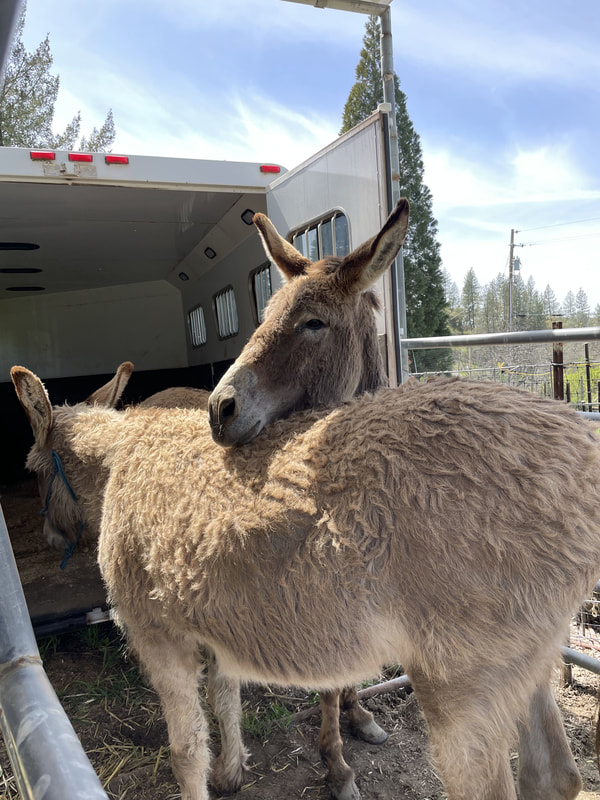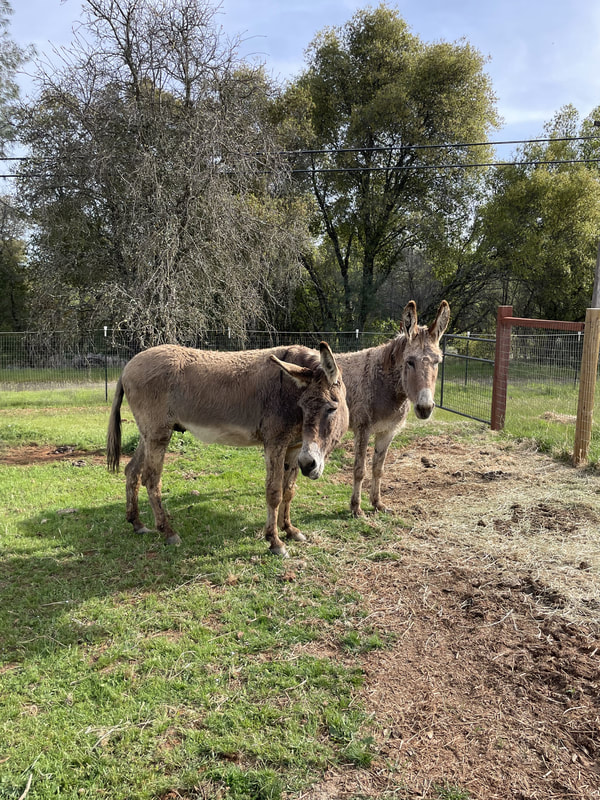Fred
Height: 12.0 hh (est)
Weight: 750 lbs (est)
DOB: <2003 (est)
Sex: Gelding
Color: Brown
Breed: Burro
DNA: 1st
2nd
3rd
Adoption Fee: $750
Category: Non-Riding Companion
Bonded pair, adopts only with Ethel
Weight: 750 lbs (est)
DOB: <2003 (est)
Sex: Gelding
Color: Brown
Breed: Burro
DNA: 1st
2nd
3rd
Adoption Fee: $750
Category: Non-Riding Companion
Bonded pair, adopts only with Ethel
Fred's Story
Fred came to AAE with Ethel in the spring of 2023. The pair had been adopted from a distressed sanctuary nearly three years prior. Unfortunately, it took considerable time for the adopters to earn the trust of these two sweet s-asses! But, they were unable to halter them, and they were unable to handle their hooves, despite their best efforts. Fred was the friendlier of the two. Though they were adored by their adopters, their adopters felt they had tried all they could to help them, and they were unable to do what was needed, so they contacted AAE to for help.
Fred and Ethel came to AAE. They were difficult to load, but Fred was more willing to consider stepping into the trailer. Eventually, one went in, and the other followed, after much discussion. They unloaded fine, and soon settled into a quarantine paddock. They were very kind and curious, especially Fred. After quarantine, they were each seen by the vet and farrier for dental and hoof care, vaccines, deworming and a microchip. Fred is not the least bit fond of his hooves being handled, and he was trimmed while under anesthesia for his dental care. It was still not easy, but he was trimmed. He's slowly getting accustomed to basic handling, haltering, and hoof care. He will likely need sedation by the vet to safely trim hooves until he can develop more trust in his person.
Fred and Ethel are available for adoption, only as a bonded pair.
In general, there is a lot of activity around AAE including foot traffic in and out of paddock/pasture areas, mucking with wheelbarrows, grooming and care activities, weekly farrier visits. There are resident dogs, cats, chickens, and mini horses, as well as various wildlife including frequent turkeys and squirrels in and around paddock/pasture areas. AAE is situated on the corner of a busy road with high speed vehicles, trucks, and sirens. Tractors are used in and around pasture/paddock areas, trucks deliver feed, and a squeeze is occasionally used for unloading hay. Neighbors have weekly gardeners that utilize various power tools, and children that are active in yards adjacent to some stall/paddock areas. Horses at AAE are accustomed to a more active environment as opposed to a quiet/sterile environment.
Fred and Ethel came to AAE. They were difficult to load, but Fred was more willing to consider stepping into the trailer. Eventually, one went in, and the other followed, after much discussion. They unloaded fine, and soon settled into a quarantine paddock. They were very kind and curious, especially Fred. After quarantine, they were each seen by the vet and farrier for dental and hoof care, vaccines, deworming and a microchip. Fred is not the least bit fond of his hooves being handled, and he was trimmed while under anesthesia for his dental care. It was still not easy, but he was trimmed. He's slowly getting accustomed to basic handling, haltering, and hoof care. He will likely need sedation by the vet to safely trim hooves until he can develop more trust in his person.
Fred and Ethel are available for adoption, only as a bonded pair.
In general, there is a lot of activity around AAE including foot traffic in and out of paddock/pasture areas, mucking with wheelbarrows, grooming and care activities, weekly farrier visits. There are resident dogs, cats, chickens, and mini horses, as well as various wildlife including frequent turkeys and squirrels in and around paddock/pasture areas. AAE is situated on the corner of a busy road with high speed vehicles, trucks, and sirens. Tractors are used in and around pasture/paddock areas, trucks deliver feed, and a squeeze is occasionally used for unloading hay. Neighbors have weekly gardeners that utilize various power tools, and children that are active in yards adjacent to some stall/paddock areas. Horses at AAE are accustomed to a more active environment as opposed to a quiet/sterile environment.






























